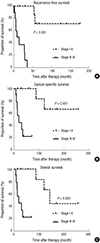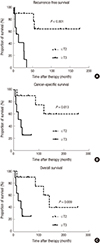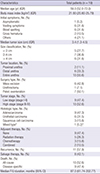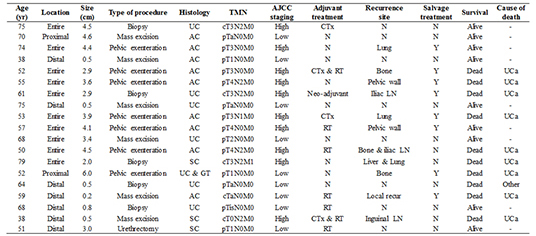1. Dalbagni G, Zhang ZF, Lacombe L, Herr HW. Female urethral carcinoma: an analysis of treatment outcome and a plea for a standardized management strategy. Br J Urol. 1998; 82:835–841.
2. Derksen JW, Visser O, de la Rivière GB, Meuleman EJ, Heldeweg EA, Lagerveld BW. Primary urethral carcinoma in females: an epidemiologic study on demographical factors, histological types, tumour stage and survival. World J Urol. 2013; 31:147–153.
3. Bracken RB, Johnson DE, Miller LS, Ayala AG, Gomez JJ, Rutledge F. Primary carcinoma of the female urethra. J Urol. 1976; 116:188–192.
4. Gakis G, Witjes JA, Compérat E, Cowan NC, De Santis M, Lebret T, Ribal MJ, Sherif AM. European Association of Urology. EAU guidelines on primary urethral carcinoma. Eur Urol. 2013; 64:823–830.
5. Dimarco DS, Dimarco CS, Zincke H, Webb MJ, Bass SE, Slezak JM, Lightner DJ. Surgical treatment for local control of female urethral carcinoma. Urol Oncol. 2004; 22:404–409.
6. Edge SB, Compton CC. The American Joint Committee on Cancer: the 7th edition of the AJCC cancer staging manual and the future of TNM. Ann Surg Oncol. 2010; 17:1471–1474.
7. Champ CE, Hegarty SE, Shen X, Mishra MV, Dicker AP, Trabulsi EJ, Lallas CD, Gomella LG, Hyslop T, Showalter TN. Prognostic factors and outcomes after definitive treatment of female urethral cancer: a population-based analysis. Urology. 2012; 80:374–381.
8. Thyavihally YB, Wuntkal R, Bakshi G, Uppin S, Tongaonkar HB. Primary carcinoma of the female urethra: single center experience of 18 cases. Jpn J Clin Oncol. 2005; 35:84–87.
9. Garden AS, Zagars GK, Delclos L. Primary carcinoma of the female urethra. Results of radiation therapy. Cancer. 1993; 71:3102–3108.
10. Benson RC Jr, Tunca JC, Buchler DA, Uehling DT. Primary carcinoma of the female urethra. Gynecol Oncol. 1982; 14:313–318.
11. Visser O, Adolfsson J, Rossi S, Verne J, Gatta G, Maffezzini M, Franks KN. RARECARE working group. Incidence and survival of rare urogenital cancers in Europe. Eur J Cancer. 2012; 48:456–464.
12. Kato H, Kobayashi S, Islam AM, Nishizawa O. Female para-urethral adenocarcinoma: histological and immunohistochemical study. Int J Urol. 2005; 12:117–119.
13. Ouzaid I, Hermieu JF, Dominique S, Fernandez P, Choudat L, Ravery V. Management of adenocarcinoma of the female urethra: case report and brief review. Can J Urol. 2010; 17:5404–5407.
14. Meis JM, Ayala AG, Johnson DE. Adenocarcinoma of the urethra in women. A clinicopathologic study. Cancer. 1987; 60:1038–1052.
15. Grigsby PW, Corn BW. Localized urethral tumors in women: indications for conservative versus exenterative therapies. J Urol. 1992; 147:1516–1520.
16. Gheiler EL, Tefilli MV, Tiguert R, de Oliveira JG, Pontes JE, Wood DP Jr. Management of primary urethral cancer. Urology. 1998; 52:487–493.











 PDF
PDF ePub
ePub Citation
Citation Print
Print




 XML Download
XML Download